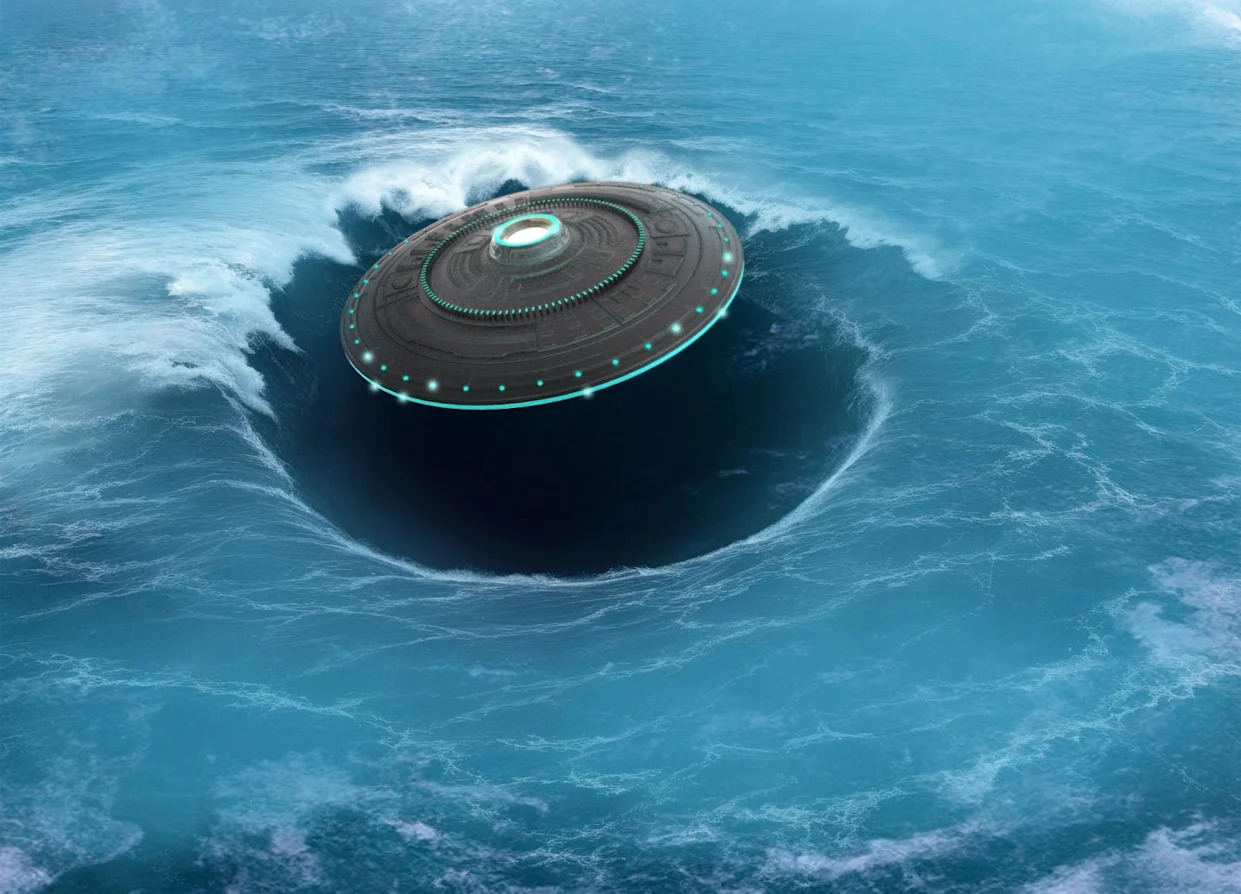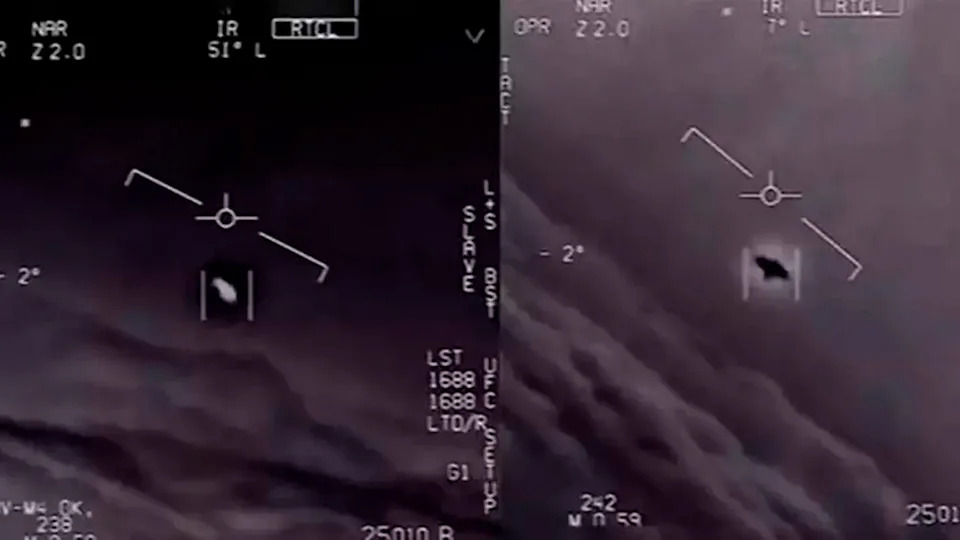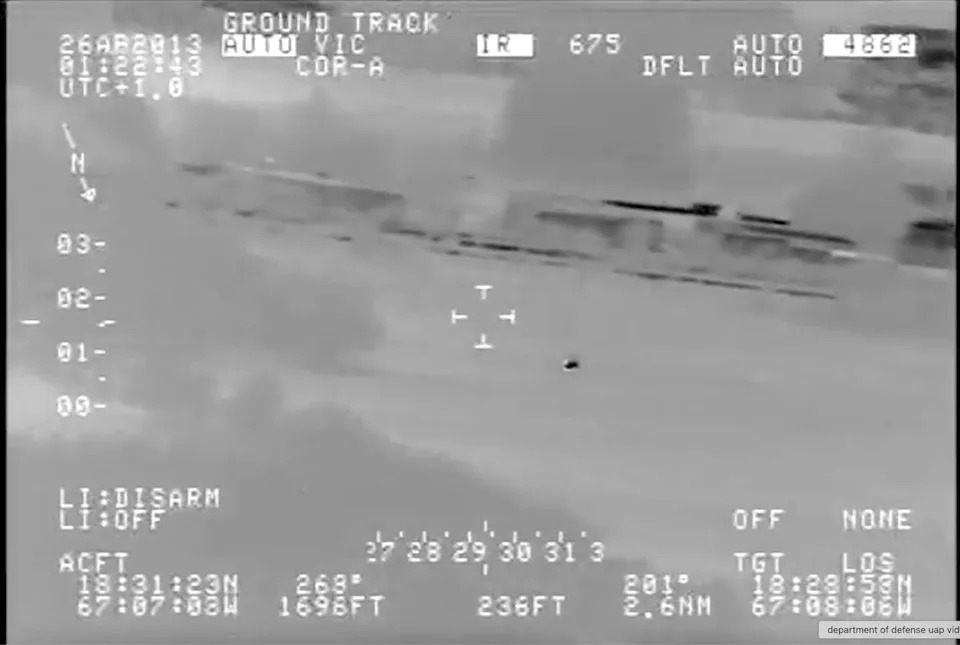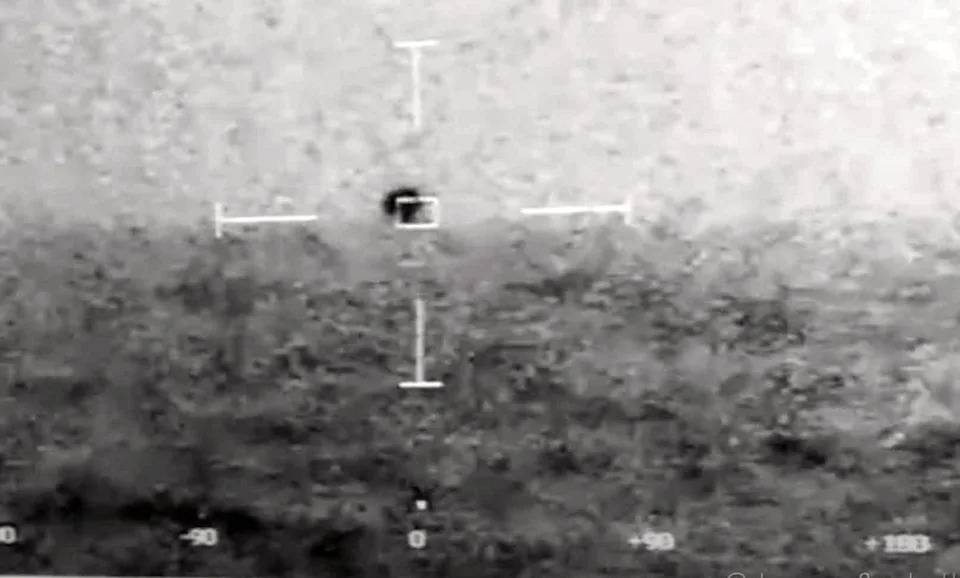
In mid-2014, during training flights off the coast of Virginia Beach, Virginia, F/A-18 pilot and U.S. Navy Lieutenant Ryan Graves began to notice something strange. The radar returns looked off—phantom blips moving with unfathomable speed and precision. At first he dismissed it as a glitch. But then the anomalies returned, recorded by the fighter jets’ sophisticated sensors. They would hover in place—and then dart away at supersonic speeds. They were recorded from the ocean’s surface to 40,000 feet.
“Sometimes stationary—0.0 Mach. Other times 250 to 350 knots.... Sometimes even supersonic—1.1 to 1.2 Mach. All altitudes. And always over the ocean,” Graves says.
After appearing only as glitches on the jets’ radar, the objects on one occasion finally came into view. Graves reported seeing a dark gray or black cube inside a clear sphere, between five and 15 feet in diameter, coming within 50 feet of their jets. “That was the turning point,” Graves says. “We started treating it as a safety issue.”
Over the next year, Graves’s squadron recorded sightings of unidentified objects almost daily. Sometimes the objects flew in loose formations. Other times they traveled alone. They had no exhaust, no visible propulsion, no wings. Sometimes the object would rotate in place; others vanished when approached. As it turned out, pilots stationed off the West Coast—on missions aboard the USS Nimitz, the USS Princeton, and other carriers—had been experiencing similar things for years.
Some of these craft—now classified as UAPs (unidentified anomalous phenomena)—appeared to be capable of transmedium travel, meaning they are able to move from air to sea without slowing, splashing, or emitting heat. They challenged every assumption held by aerospace engineers and radar operators.
Graves doesn’t claim to know what the objects were. But one thing was clear. “This wasn’t business as usual,” he says. “There was a serious issue at play. It wasn’t just one rogue object. It wasn’t just us on the East Coast. It wasn’t just my squadron. It was a pattern. This was global.”
Since at least the 1950s, military sources have reported strange objects plunging into the ocean—what they call USOs (unidentified submerged objects). These phenomena exhibit characteristics that conflict with our understanding of physics and maritime navigation. As radar and similar technologies have advanced, so have the number of sightings.

Today Graves is one of the most vocal advocates for UAP transparency. Now retired from the military, he’s the founder of Americans for Safe Aerospace, the largest UAP-focused pilot safety initiative in the world, and works with former Pentagon and naval officials to push for greater transparency. He doesn’t claim that these craft are alien, but he’s certain that they aren’t using known human tech. “Where that leaves us opens up options—extraterrestrial visitors, time travelers, breakaway civilizations... things that challenge the status quo and aren’t easily accepted at face value,” he says.
Rear Admiral Tim Gallaudet, PhD, an oceanographer, was one of the first to view footage from the UAP incidents in 2015 involving fighter jets attached to the USS Theodore Roosevelt, which at the time was conducting training exercises off the coast of Florida. Two videos captured by Navy fighter jets that were made public in 2020 show strange craft flying at incredible speeds with no visible means of propulsion, sometimes rotating in midair. “I knew then that what I saw was not our technology. We don’t test experimental aircraft in training ranges—it’s too dangerous—and I had access to everything classified. No nation has craft that can move like that,” he says.
Gallaudet, now retired from the Navy and currently the CEO of Ocean STL Consulting, is pushing for the U.S. government to treat these phenomena as a “national research priority.” Despite some public disclosures, many records remain classified, buried within defense contractor vaults or shielded by national security exemptions. If even part of what’s been reported is true, then the encounters off Virginia, California, and elsewhere could be the opening chapter in a much deeper mystery—one that spans oceans, navies, and continents.
This spring, Graves and Gallaudet briefed officials in Washington, D.C., on unidentified submerged objects. “We’re at a unique moment in history,” Graves says. “People have access to tools that can reveal things. The momentum is building.”
That momentum has already begun reshaping policy. In 2023, Congress passed the UAP Disclosure Act, legislation requiring federal agencies to collect, catalog, and disclose records related to recovered nonhuman craft and biologics. For the first time, U.S. law openly acknowledged the potential existence of off-world or nonhuman intelligence, and even hinted at craft retrieval and reverse engineering programs.
Those newly released records contain a trove of details on previously classified encounters with multiple transmedium UAPs. None definitively prove that otherworldly beings are hiding in or above our oceans, but they do raise questions that neither our military nor scientific experts can explain.
“The possibility that they exist underwater is very real,” Gallaudet says. “They could come from another galaxy, if they’ve conquered the engineering challenge of that,” he says. “Or why not—maybe they lived here for a long time, before we even evolved, and sought safety from the Earth’s atmospheric and geologic cataclysms by creating a habitat or place to live beneath the seafloor.... That’s one hypothesis.”
The following four incidents have provided investigators with the most compelling—and perplexing—evidence so far of transmedium encounters with what experts like Gallaudet believe could be nonhuman in origin.

USS Nimitz, 2004
In November 2004, several U.S. Navy pilots assigned to the USS Nimitz encountered a Tic Tac–shaped UAP darting and dashing over the Pacific. According to reports that followed, the object lacked visible control surfaces and heat signatures that would be typical of jet aircraft or rockets. It never made a sonic boom, although it appeared to be traveling faster than the speed of sound.
The incident began when the USS Princeton, a guided-missile cruiser escorting the Nimitz off the coast of San Diego, picked up strange radar contacts. The objects appeared at 80,000 feet, and then dropped to sea level in less than a second. F/A-18 Commander David Fravor and Lieutenant Commander Jim Slaight scrambled to intercept the object. Each man claims to have seen a smooth, white oblong object around 30 to 40 feet long, with no wings, no windows, no markings. It hung in the air just over the sea.
As Fravor circled downward, the object suddenly shot away, vanishing in seconds. “It just disappeared. Like a bullet out of a gun,” Fravor told Fox News.
The strike group dispatched a second flight. This time the object was captured on an infrared camera showing a white speck flying against the wind, rotating and maneuvering in ways no known aircraft can.

Aguadilla, Puerto Rico, 2013
One of the most hotly debated encounters of an unidentified submerged object came in April 2013, when an infrared surveillance camera operated by U.S. Customs and Border Protection captured something extraordinary over Aguadilla, Puerto Rico. A small spherical object flew inland from the ocean, crossed the airport, and then returned to sea—where it maneuvered in ways that appeared to defy physics.
The three-minute video, published by the Scientific Coalition for UAP Studies, has become a key piece of evidence suggesting the possibility of transmedium travel. It shows the object entering the water without slowing down—no splash, no wake, no disruption. Seconds later it resurfaces, splits in two, and then submerges again. Any object passing between two mediums should generate drag or turbulence or, at the very least, a splash, according to the laws of hydrodynamics. But this one behaved as if those laws didn’t apply.
“It’s not that they break the laws,” Gallaudet says. “It’s that they demonstrate engineering capabilities we haven’t yet developed. We can’t build anything that can do that today.”
“I’ve spoken with the pilots who saw it,” he adds. “The near-instantaneous acceleration of that craft is something we just can’t engineer.”

Caribbean Sea, Unspecified date
In the 1990s, a Navy CH-53 Sea Stallion pilot was flying off the coast of Puerto Rico when he saw something he couldn’t explain. His crew, on a routine mission to retrieve a BQM target drone that had previously been dropped into the ocean, had sent a diver into the water to connect the drone to the helicopter’s hoist system. But just before the helo was about to lift the 20-foot-long drone out of the sea, something pulled it violently downward. The pilot, whose name has not been disclosed, would later report that the object was a large, dark mass unlike any submarine or marine animal he’d ever seen.
After F/A-18 Commander David Fravor went public with the previous incident he witnessed flying off the USS Nimitz, he says the Sea Stallion pilot contacted him to relay the story. Fravor then shared details on Joe Rogan’s podcast in 2019.
“The helo drops a swimmer in the water, he hooks the whole thing up, and they fly back,” Fravor said. “The first time they were out and they were going to pick up a BQM, he’s sitting in the front—in the CH-53 you can see down by your feet—and as he’s looking down, they’re 50 feet above the water, he sees this kind of dark mass coming up from the depths.”
As the pilot picked up the BQM, he was apparently at a loss for words. “He’s looking at this thing going, ‘What the hell is that?’ And then it just goes back down underwater. Once they pull the kid and the BQM out of the water, this object descends back into the depths.”

USS Omaha, 2019
It began as a blip. In July 2019, an infrared camera aboard the USS Omaha captured something that defied explanation: a spherical object moving swiftly over the Pacific before dropping into the ocean—again, no splash, no wake, no debris. The footage, later verified by Pentagon officials, stunned observers. The object didn’t resemble any known drone, missile, or aircraft. And its disappearance beneath the waves raised new questions about transmedium tech.
In the incident, the crew of the Omaha (which was also sailing off the San Diego coast) recorded a spherical UAP hovering just over the surface of the Pacific Ocean. The ship’s sensor that caught the object was the sophisticated AN/KAX-2—a stabilized sensor turret built for maritime environments that includes a digital video camera, night vision camera, and laser rangefinder.
The video shows a recording of the AN/KAX-2 screen and appears to have been taken with a night vision camera. The object seemingly moves, tracked by the sensor operator, and then hovers just above the ocean’s surface. Then the object disappears.
“It looked nothing like any known aircraft,” Gallaudet says. “After I testified before Congress last year, a sailor who had been on the bridge of the Omaha contacted me. He said the object was just one of many—and that he’d witnessed a similar event aboard the USS Jackson in 2023.”
You Might Also Like





Comments